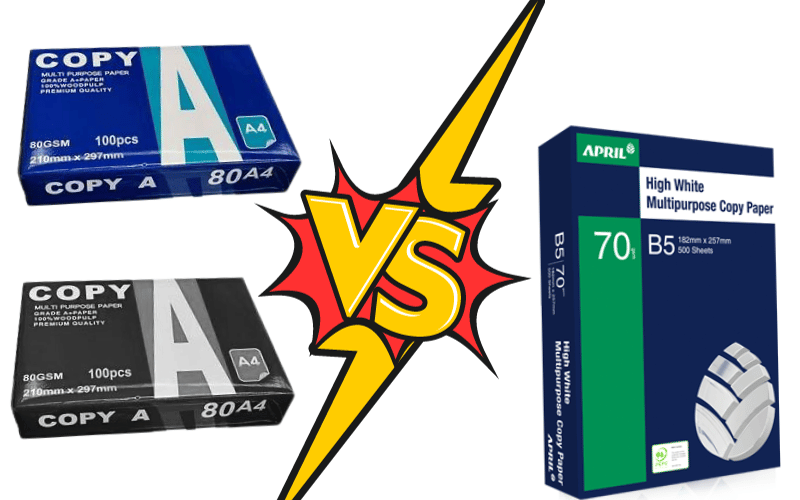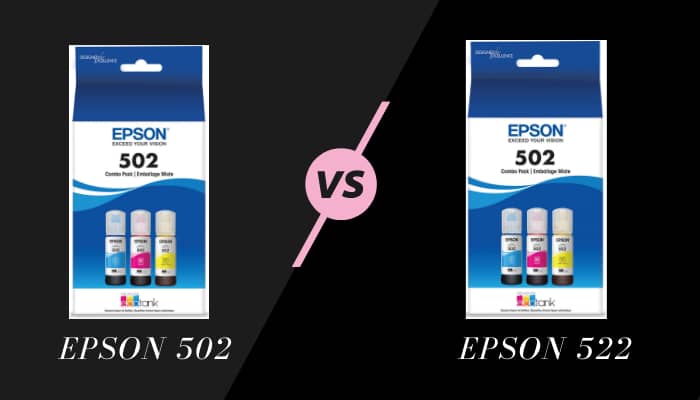In the world of stationery and document management, B5 paper size may seem like a trivial detail, but it plays a vital role in various contexts, influencing everything from design and printing to note-taking and organization. Two paper sizes that frequently find their way into our daily lives are A4 and B5. These seemingly similar dimensions often leave individuals pondering which one best suits their needs.
In this blog post, we will delve into the significance of paper size, explore the commonality between A4 and B5, and guide you through the key points that will help you make an informed decision when choosing between these two sizes for your specific tasks and preferences.
Whether you’re an artist, a student, a professional, or simply someone seeking the perfect stationery fit, understanding the distinctions between A4 and B5 will prove invaluable in your paper-related endeavors.

A4 Paper Size
Dimensions:
A4 paper measures 210 x 297 millimeters, which is approximately 8.27 x 11.69 inches. These precise measurements are a result of international standardization, primarily defined by the ISO (International Organization for Standardization). ISO 216 is the standard that A4 adheres to, ensuring consistency in paper sizes across the globe.
Common Uses
A4 paper is exceptionally versatile and finds extensive use in various applications. Some common uses include:
Printing: A4 is the standard size for printing documents, reports, essays, and most other written materials. It’s compatible with both inkjet and laser printers, making it the go-to choice for home and office printing.
Business Documents: A4 is widely used for business correspondence, letterheads, invoices, and contracts. Its professional appearance and ample space make it ideal for creating well-organized documents.
Academic Purposes: In the academic world, A4 paper is the standard for printing assignments, research papers, and lecture notes. It provides sufficient space for charts, graphs, and written content.
Art and Design: Many artists and graphic designers prefer A4 sheets for sketching, doodling, and creating smaller artworks. It’s a convenient size for brainstorming and initial drafts.
Pros and Cons
Advantages of A4 Paper
- Widespread Availability: A4 paper is readily available almost everywhere, making it convenient to purchase.
- Compatibility: It fits perfectly into most binders, folders, and portfolios, making it an excellent choice for organizing documents.
- Printability: A4 is the standard for printers and copiers, ensuring that documents can be printed consistently.
- Space Efficiency: It strikes a balance between providing enough writing or printing space while remaining compact and easy to handle.
Drawbacks and Limitations
- Size Constraints: For large diagrams, posters, or presentations, A4 may be too small, necessitating the use of larger paper sizes.
- Visual Impact: In design or artistic contexts where larger formats are desired for impact, there may be better choices than A4.
- Folded Documents: When A4 documents need to be folded for distribution, the crease can sometimes disrupt the readability and aesthetics of the content.
In summary, the A4 paper’s standardized dimensions and widespread use make it a practical choice for various applications. However, it’s essential to consider your specific needs and the potential limitations of this size when deciding whether it’s the right fit for your task.
B5 Paper Size
Dimensions:
B5 paper measures 176 x 250 millimeters, which is approximately 6.93 x 9.84 inches. These dimensions are part of the B series of paper sizes, which were developed to complement the A series sizes and are defined by the ISO 216 standard.
Origin and Purpose of the B Series Paper Sizes:
The B series paper sizes, including B5, were introduced to provide a range of paper sizes that maintain a consistent aspect ratio with the A series sizes. This means that B5 is designed to be exactly half the size of A4.
The purpose of the B series is to offer paper sizes that are suitable for applications where the proportions of the paper need to be maintained when scaling from one size to another. This consistency in aspect ratio makes the B series particularly useful for tasks such as bookbinding, where pages need to be resized without distorting content.
Common Uses
B5 paper is commonly used in various contexts, particularly in:
Notebooks and Journals: B5 notebooks and journals are popular among students and professionals for note-taking, sketching, and organizing ideas. The slightly larger size compared to A5 offers more writing space while remaining portable.
Diaries and Planners: Many diaries and planners are designed to accommodate B5 pages. The extra space allows for detailed planning and scheduling.
Letter Writing: B5 is suitable for personal and business correspondence, offering ample space for letter writing.
Art and Design: Artists and designers often use B5 paper for sketching, storyboarding, and initial drafts. The size provides room for creativity while still being manageable.
Pros and Cons
Advantages of B5 Paper
- Adequate Space: B5 offers more writing and drawing space compared to smaller sizes like A5, making it versatile for various tasks.
- Portability: While larger than A4, B5 is still compact and easy to carry in bags and backpacks, making it suitable for on-the-go note-taking.
- Aspect Ratio Consistency: B5’s aspect ratio ensures that scaling from other B series sizes maintains the same proportions, which is useful in bookbinding and printing.
- Organizational Use: The size is convenient for creating organized notes, making to-do lists, and structuring information.
Drawbacks and Limitations
- Not Standard for Printing: B5 is not as widely supported by printers and copiers as A4, which may require special settings or resizing for printing documents.
- Size Preference: Some individuals may find B5 either too large or too small for their specific needs and may prefer other paper sizes accordingly.
- Availability: While B5 paper is available, it may not be as commonly stocked as A4, so it might require some searching.
In summary, the B5 paper’s dimensions and aspect ratio make it a versatile choice for various writing and note-taking scenarios. It strikes a balance between size and portability, but its suitability depends on your specific needs and preferences.
Comparison Between A4 and B5 Paper Size
Size Differences
A4 and B5 paper sizes exhibit distinct differences in their dimensions. A4 measures 210 x 297 millimeters (approximately 8.27 x 11.69 inches), while B5 is slightly smaller at 176 x 250 millimeters (approximately 6.93 x 9.84 inches). The primary disparity lies in A4 being taller and narrower than B5, with A4 having a more elongated shape compared to the slightly square B5 dimensions.
Functionality
The functionality of A4 and B5 paper sizes varies depending on the intended use:
Note-Taking: A4 offers more writing space, making it suitable for extensive note-taking, especially in academic or professional settings where detailed records are required. B5, while still providing ample space, is more compact and portable, making it convenient for quick notes, journals, or diary entries.
Printing: A4 is the standard for printing documents worldwide. It’s compatible with most printers, photocopiers, and multifunctional devices. B5, on the other hand, may require resizing or specific settings on some printers.
Sketching and Art: Both sizes are commonly used for sketching and initial drafts, with artists and designers preferring the larger A4 for more detailed work and the slightly smaller B5 for quick sketches and brainstorming.
Portability
Portability is a critical factor for many users, and the choice between A4 and B5 depends on different use cases:
A4: A4 paper, being taller and narrower, can be less convenient for carrying in smaller bags or folders. However, it fits well in most briefcases, larger backpacks, and document organizers.
B5: B5’s dimensions are slightly more compact and square, making it easier to carry in smaller bags, journals, or notebook covers. It’s a popular choice for students and professionals who need a balance between space and portability.
Cost
When comparing the cost of A4 and B5 paper, there are a few factors to consider:
Price per Sheet: A4 paper is often more cost-effective per sheet because of its standardization and widespread availability. B5 paper might be slightly more expensive per sheet due to its less common size.
Availability: A4 paper is readily available in most stationery stores, making it easy to find. B5 paper might require more effort to locate, especially in regions where it’s less commonly used.
Usage Volume: If you use paper in large quantities, the price difference per sheet can become more significant, making A4 a cost-effective choice.
In conclusion, the choice between A4 and B5 paper depends on your specific needs. A4 offers more space for extensive tasks, while B5 is more portable and can be cost-effective for smaller-scale usage.
Choosing the Right Size:
When it comes to selecting the right paper size for your needs, it’s crucial to take into account various factors that align with your specific requirements. Paper size can greatly impact your productivity, organization, and overall satisfaction with your stationery. Here are some guidelines to help you make an informed choice:
Consider Your Needs
Before making a decision, pause to evaluate your particular needs and use cases for the paper. Ask yourself the following questions:
Purpose: What will you primarily use the paper for? Is it for note-taking, printing documents, sketching, or a combination of these?
Quantity: How much paper do you anticipate using regularly? Will it be for occasional tasks or frequent, high-volume work?
Portability: Do you need your paper to be easily transportable? Will you carry it in a bag, backpack, or briefcase?
Printing: Will you be printing documents regularly, and do you need compatibility with standard printers?
Organization: Do you require a specific paper size to fit into existing binders, folders, or notebooks?
Recommendations
Based on different scenarios, here are some recommendations for when to choose A4 and when to choose B5 paper:
Choose A4 When
Printing is a significant part of your work, as A4 is the standard for most printers worldwide.
You need to create detailed, extensive notes or documents with ample space for content.
You prefer a paper size that’s compatible with standard binders and folders.
Portability is not a primary concern, and you have larger bags or document organizers.
Choose B5 When
Portability is essential, and you need a size that fits comfortably in smaller bags or notebook covers.
You want a balance between space and portability for note-taking or journaling.
You’re an artist or designer looking for a more compact canvas for sketches and creative work.
The aspect ratio consistency of the B series is important for your specific use, such as bookbinding.
Personal Preference
Ultimately, personal preference plays a significant role in choosing the right paper size. Some individuals may have a strong preference for one size over the other based on their writing style, hand size, or the feel of the paper. Experiment with both A4 and B5 to determine which size aligns best with your comfort and creative needs. Remember that the choice is not one-size-fits-all, and what matters most is your satisfaction and productivity when using the paper.
In conclusion, the comparison between A4 and B5 paper sizes has shed light on the distinctive attributes and functionalities of each. A4, with its widespread compatibility and ample space, suits those who engage in extensive printing and document creation. Conversely, B5’s more compact dimensions make it an excellent choice for portability and versatile note-taking scenarios.
The decision between the two ultimately hinges on your specific needs and preferences. We encourage you to weigh factors such as purpose, portability, and printing requirements when making your choice.
If you have further questions or insights to share, we invite you to join the conversation and leave your comments below. Your experiences can enrich this ongoing dialogue about the perfect paper size for diverse tasks.






